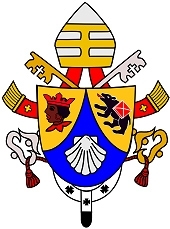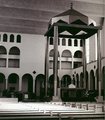|
|
|
Documents
Dans sa dépêche de ROME, Mardi 26 avril 2005 Zenit écrit que le pape Benoît XVI prend comme blason le blason de son épiscopat à Munich et Freising avec les symboles du Maure couronné, de l'ours et de la coquille. Voir les explications détaillées sur ces trois symboles à la fin de cet article.
L'Agence Zenith poursuit en expliquant que il y a une nouveauté. En effet ce blason pontifical sera surmonté de la mitre papale, au sommet de forme triangulaire, et non plus de la tiare, comme pour les blasons de ses prédécesseurs. Il sera aussi orné du pallium métropolite qui a pris une si grande place symbolique dans linauguration du pontificat, dimanche 24 avril : les couleurs sont encore à létude. Le blason reprend donc la tête couronnée du « Maure de Freising », tournée vers la gauche : un emblème présent dès 1316 dans les armes de lévêque Conrad III et de tous ses successeurs. A droite du Maure est représenté lours avec le bâton qui a servi à le faire aller à Rome, selon la légende de saint Corbinien racontée par Joseph Ratzinger dans son autobiographie (Ma vie, Souvenirs », Fayard, cf. ZF050419). Une note du diocèse de Freising explique le symbole en ces termes : « Le christianisme a apprivoisé le sauvage paganisme et a posé ainsi dans lantique Bavière les fondements dune grande culture ». En outre, en tant que « porteur de Dieu », lours de Corbinien symbolise la charge épiscopale." "En bas, le troisième symbole est celui de la coquille, qui renvoie comme nous le rappelions le 19 avril, à la fable de saint Augustin : en 1953, la thèse de théologie de Joseph Ratzinger portait justement sur « Le peuple et la maison de Dieu dans lenseignement de saint Augustin sur lEglise ». Cest aussi la coquille du pèlerin emblème des pèlerins de Saint-Jacques de Compostelle qui représente, selon les termes du concile Vatican II « le peuple de Dieu pérégrinant » dont Benoît XVI est devenu le pasteur : une image placée sur le blason du couvent des Ecossais de Ratisbonne, où le prof. Ratzinger a enseigné la Dogmatique et lHistoire de 1969 à 1977. ZF05042606 ___________________________________ EXPLICATIONS DÉTAILLÉES SUR LES SYMBOLES DU MAURE, DE L'OURS ET DE LA COQUILLE Le Maure couronné, la coquille et lours, ces trois symboles du pape Benoît XVI signifient « luniversalité » de lEglise, « sans acception de personne », la « marche permanente » du chrétien, et la « bête de trait », au « service » de Dieu. Il avait pour devise épiscopale: « Coopérateurs de la vérité ». Dans son petit volume intitulé: « Ma vie, souvenirs (1927-1977) ». Benoît XVI explique que sur les armoiries des évêques de Freising et de Munich figure depuis environ mille ans le MAURE COURONNÉ: on ne sait pas bien ce quil signifie. Pour moi, il exprime luniversalité de lEglise, sans acception de personne, ni de race ni de classe, car nous sommes tous « un » dans le Christ (Galates 3, 28) ». Il ajoute lexplication de deux autres symboles. « Jai choisi pour moi deux autres symboles: en premier lieu la COQUILLE, dabord signe de notre pèlerinage, de notre marche: « Nous navons pas de cité permanente sur le terre ». Mais elle me rappelait aussi une légende selon laquelle saint Augustin, méditant sur le mystère de la Sainte Trinité, vit un enfant sur la plage jouer avec un coquillage, à laide duquel il essayait de puiser leau de la mer dans un trou. Et cette parole lui aurait été donnée : il est plus difficile à ton intelligence dappréhender le mystère divin que de transvaser la mer entière dans un petit trou. Ainsi la coquille me rappelle mon grand maître saint Augustin, mes travaux de théologie et la grandeur du mystère qui dépasse toute science ». (pp. 141-142) A propos de lOURS, Benoît XVI raconte la légende de saint Corbinien de Freising. Un ours dévora le cheval du saint évêque en route pour Rome. Lours dut porter le chargement du cheval. Le cardinal rapproche cette légende de linterprétation que saint Augustin fait dun verset de psaume : « Il avait choisi la vie de chercheur et avait été destiné par Dieu à être une « bête de somme », un buf docile qui tire la charrue de Dieu en ce monde ». Il explique : « Lours qui remplaça le cheval ou plutôt le mulet de saint Corbinien et fut chargé de son fardeau, qui devint sa bête de somme (contre son gré), nest-il pas limage de ce que je dois faire et de ce que je suis ? « Je suis devenu ton mulet chargé de ton joug, et cest ainsi que je suis tout près de Toi pour toujours ». » (p. 143) Le cardinal, aujourdhui pape Benoît XVI conclut : « Quels détails ajouterai-je sur mes années dépiscopat ? On raconte quà son arrivée à Rome Corbinien remit lours en liberté. Quil soit allé dans les Abruzzes ou retourné dans les Alpes, cela nintéresse pas la légende. Quant à moi jai, entre-temps, fait mes valises pour Rome et depuis longtemps je marche, mes valises à la main, dans les rues de la Ville éternelle. Jignore quand on me donnera congé, mais je sais que cela vaut pour moi aussi : «Je suis devenu ta bête de somme ; et cest justement ce que je suis auprès de Toi ». » (p. 144) Tiré de SME-Infonet http://www.webzinemaker.com/sme/, webzine publié par la Société des prêtres du Séminaire de Québec. ________________________________ Le National Catholic Reporter fait état d'un grand changement en 2010 qui vient refaire complètement les amoiries de Benoît XVI et qui laisse à réfléchier. Voici l'article de Jerry Filteau en anglais. Has Pope Benedict changed his coat of arms? by Jerry Filteau on Oct. 12, 2010 I got a strange e-mail alert Oct. 11 that Pope Benedict XVI has apparently changed his original papal coat of arms. Most notably, he has replaced his original episcopal miter atop the shield or escutcheon with the more traditional papal tiara a triple crown associated for centuries with the temporal as well as spiritual authority of the papacy. The new coat of arms was unveiled Oct. 10 in a banner unfurled below the window of the papal study in the Apostolic Palace overlooking St. Peters Square, just before Benedict made his regular Sunday appearance there to speak and lead the noonday Angelus. The new oneThe new one Also notable in the new coat of arms was the disappearance of a chalice-shaped shield of other recent popes in favor of a more elaborate escutcheon that is surrounded in gold and bears no resemblance at all to a chalice. A Benedict XVI innovation below the escutcheon at the time of his election the papal pallium with three of its six crosses in red has been replaced in the new version with a pallium showing four crosses which if shown on its reverse as well would raise the traditional number of crosses on the pallium from six to eight. Also, in the crossed gold and silver keys above the shield recalling Christs promise to Peter that what he binds on earth shall be bound also in heaven the traditional red cord with tassels linking the two keys (invisibly by an implied extension behind the shield) has been replaced by two distinct golden cords, one rising to the head of the golden key, the other rising to the head of the silver key. As I looked at the new coat of arms it brought back vivid memories of Oct. 22, 1978, in St. Peters Square, when I heard Pope John Paul II, in his homily marking the inauguration of his Petrine ministry, declare: In past centuries, when the successor of Peter took possession of his see, the triregnum or [three-tiered] tiara was placed on his head. The last pope to be crowned was Paul VI in 1963, but after the solemn coronation ceremony he never used the tiara again and left his successors free to decide in this regard. Pope John Paul I, whose memory is so vivid in our hearts, did not wish to have the tiara; nor does his successor wish it today. This is not the time to return to a ceremony and an object considered, wrongly, to be a symbol of the temporal power of the popes. The old oneThe old one At the time, I thought two things: First, obviously John Paul II did not want to tie the hands of his successors, as to whether they would return to a papal coronation with a triple tiara instead of a more simple and pastoral solemn inauguration into their ministry as bishop of Rome and universal pastor. Second, I detected a possible, perhaps even palpable, note of wistfulness: Did John Paul regret that because of the spirit of the times in 1978, he could not be crowned pope with the tiara that he described as considered, wrongly, to be a symbol of the temporal power of the popes? His use of wrongly certainly exhibited not just an opening to some future resumption of that tradition but a strong leaning toward it in some changed future atmosphere of public opinion. When Benedict became the first pope in centuries to replace the triple crown above his heraldic papal shield with an episcopal miter, I thought that perhaps the final dagger had been thrust into the beast of papal claims of temporal power, symbolically completing Paul VIs decision not to use the crown after his coronation and the decisions of John Paul I and II not to be crowned at all. The new version of papal heraldry draws not only that but several other issues into question. Why are the tassled cords to the two keys representing Peters power to release from sins on earth and in heaven no longer linked? Why has the traditional chalice shape of the papal shield been abandoned? Less significantly: * Why have the original six peaks on the Moorish crown on the upper right (left from a viewers standpoint) of Benedicts heraldic shield been changed to three? * Why have the originally black stripes on the pack borne by the bear on the upper left (right from a viewers standpoint) been changed to white or silver? * Why has the golden scallop shell on the main lower portion of the escutcheon been changed from a traditional realist image to a more artistic rendering? To my knowledge, no recent pope before Benedict has changed the coat of arms he adopted at the start of his papacy. The rationale for his changes rightfully deserves lively and critical discussion. What signals is the pope trying to send in the changes he has initiated? Traditionally in heraldry, whether civic or ecclesiastical, my understanding has been that once a person adopts a set of heraldic symbols, he accepts them for life unless a new office calls for a review and possible change. For the pope to change the heraldry he adopted at the start of his papacy is, to my limited knowledge, probably without precedent. [Jerry Filteau is NCR Washington correspondent.] |
Mon site internet DERNIÈRES HOMÉLIES
Galerie
Dernières notes
Prière, manque et désir
27/01/2019
350e séminaire
année de la miséricorde
Benoît XVI
bernard émond
catholique
christ
croix
église
espérance
esprit saint
évangélisation
évêques
foi
futurs prêtres
grand séminaire
hermann giguère
histoire
marco veilleux
miséricorde
nouvelle évangélisation
pape
pape françois
pâques
pastorale
pierre gaudette
prêtres
prière
québec
renouveau charismatique
résurrection
rome
séminaire
séminaire de québec
séminaristes
société
spiritualité
synode
témoignage
valeurs
vie
Liste de liens
|
|
Le blogue d'Hermann Giguère prend le relais du webzine du Séminaire de Québec.
Début du webzine: 7 mars 2005. Début du blogue: 2 mars 2011 et refonte le 20 novembre 2014. Merci de votre visite. Site internet |
|












Documents
Commentaires (0)